Refer to the exhibit:

After implementing a new design for the network, a technician reviews the pictured CLI output as part of the MOP.
Which two statements describe what the technician can ascertain from the ImpNull output? (Choose two.)
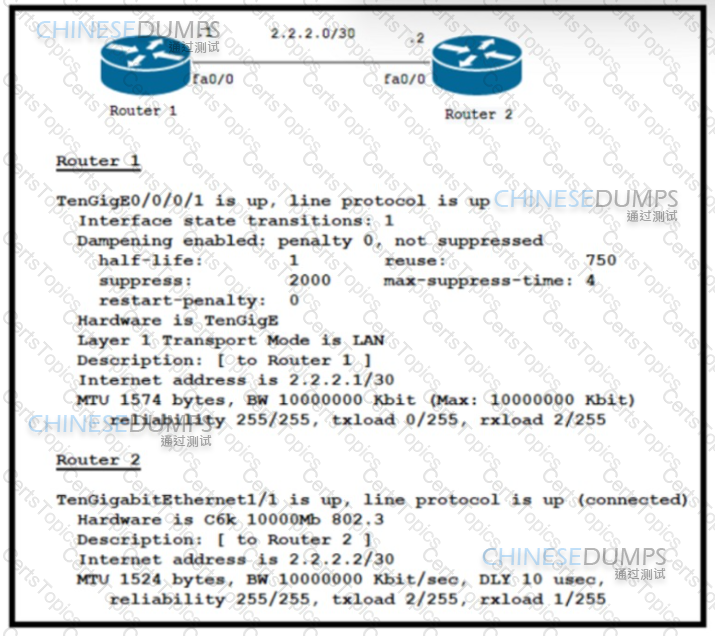
Refer to the exhibit. Router 1 and Router 2 were installed in the data center. Router 1 is the core router in the network, but it fails to establish an OSPF peering with Router 2. and customer traffic is unable to pass. Router 1 also reports an increase in CPU and memory usage. However, the CPU for R2 is stable. Which action resolves this issue?
Which two tasks must you perform when you implement LDP NSF on your network? (Choose two.)
Refer to the exhibit.

An engineer is configuring multitiopology IS-IS for IPv6 on router R1. Which additional configuration must be applied to complete the task?
A)

B)

C)

D)

Refer to the exhibit.

An engineer applied a gRPC dial-in configuration on customer's router to provide connection multiplexing and two-way streaming. What does this configuration accomplish in a gRPC?
Refer to the exhibit:

An engineer is preparing to implement link aggregation configuration.
Which statement al about this configuration is true?
After a possible security breach, the network administrator of an ISP must verify the times that several different users logged into the network. Which command must the administrator enter to display the login time of each user that activated a session?
Refer to the exhibit.
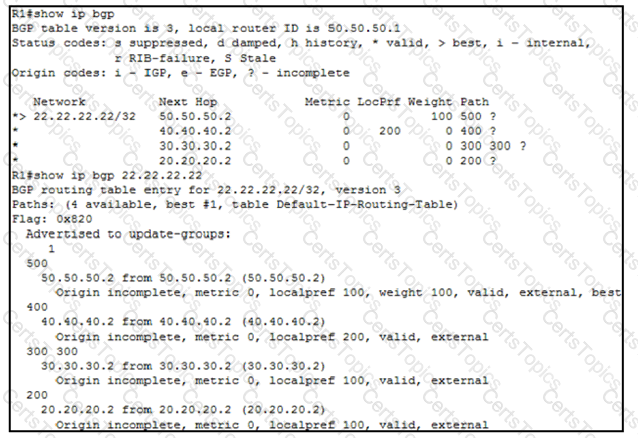
An engineer wants to determine which paths are best, second best, third best, and fourth best. Drag and drop the peer addresses on the left to the corresponding BGP best-path selection order on the right.

Refer to the exhibit.
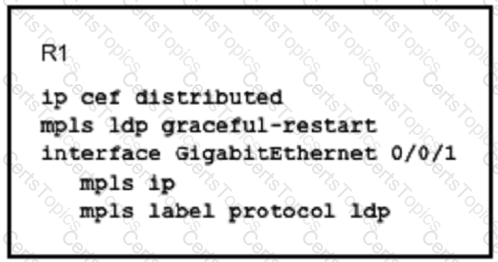
What is the effect of this configuration?
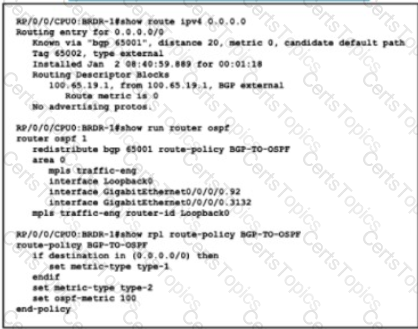
Refer to the exhibit. Router BRDR-1 is configured to receive the 0.0.0.0/0 and 172.17.1.0/24 network via BGP and advertise then into OSPF area 0. An engineer has noticed that the OSPF domain is receiving only the 172.17.1.0/24 route and default router 0.0.0.0/0 is still missing. Which configuration must an engineer apply to resolve this problem?
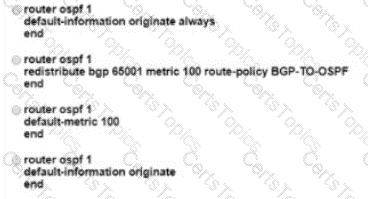
How does SR policy operate in Segment Routing Traffic Engineering?
Drag and drop the descriptions from the left onto the corresponding OS types on the right.

A network engineer must configure a router for Flexible NetFlow IPFIX export. The IP address of the destination server is 172.17.12.1. The source address must be set to the Loopback0 IPv4 address and exported packets must be set to DSCP CS3. The TTL must be 64 and the transport protocol must be set to UDP with destination port 4739. Which configuration must the engineer apply to the router?
Refer to the exhibit:

What does the REST API command do?
You are creating new Cisco MPLS TE tunnels. Which type of RSVP message does the headend router send to reserve bandwidth on the path to the tunnel’s router?
Refer to the exhibit.
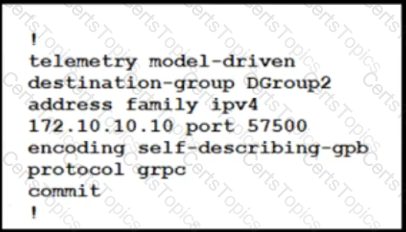
A network engineer at a large ISP Is configuring telemetry streams to monitor the health status of PE routers on the network using gRPC dial-out. The PE routers are located at several data centers in different physical locations, and they are using IS-IS and BGP for routing. Which additional configuration must the engineer implement on the PE routers to meet the goal?
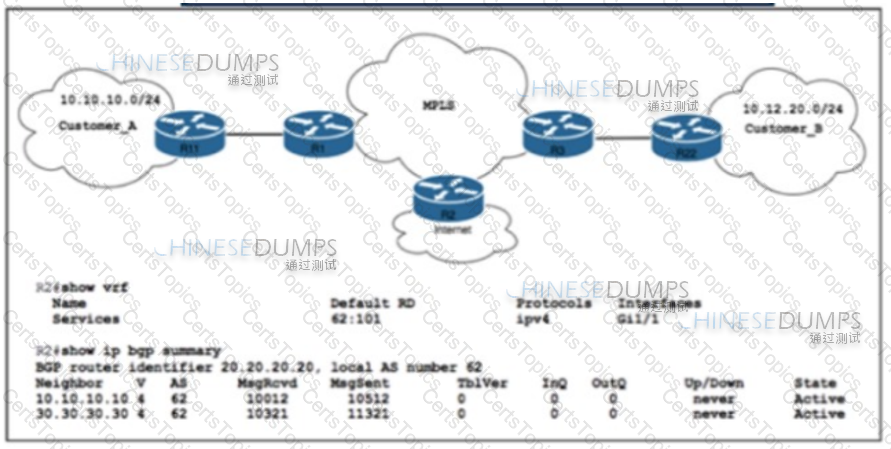
Refer to the exhibit. ISP_A is about to launch a new internet service. ISP_A is already providing MPLS VPN Layer 3 services to Customer_A and Customer_B, which are connected to ISP_A via OSPF. A network engineer completed the BGP and VRF configurations on R2 to support the new internet service. Which additional action completed the launch?
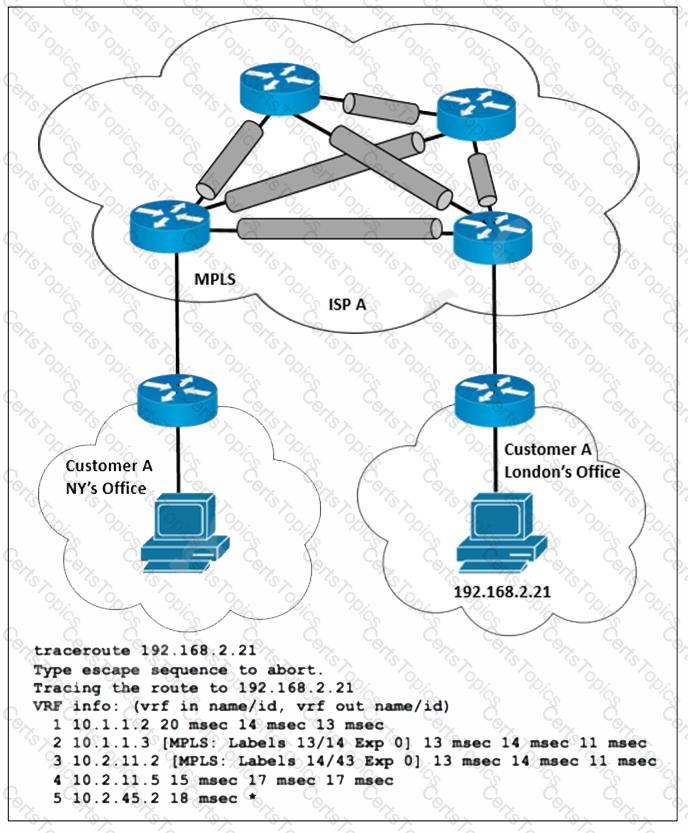
Refer to the exhibit. ISP A provides MPLS L3VPN service to customer A with BGP as the external routing protocol. Customer A has just opened a new branch office in London and requested the service provider to implement lossless service between its two offices. The LDP is enabled over the MPLS backbone and label exchange is working normally. Which action must the ISP engineering team take to enable the service?
Simulation 8
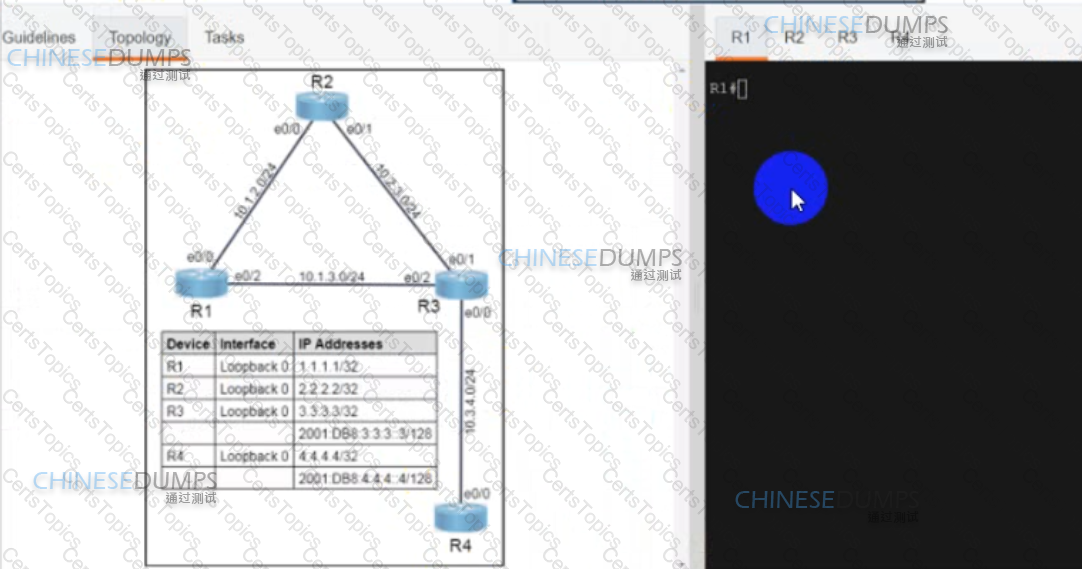
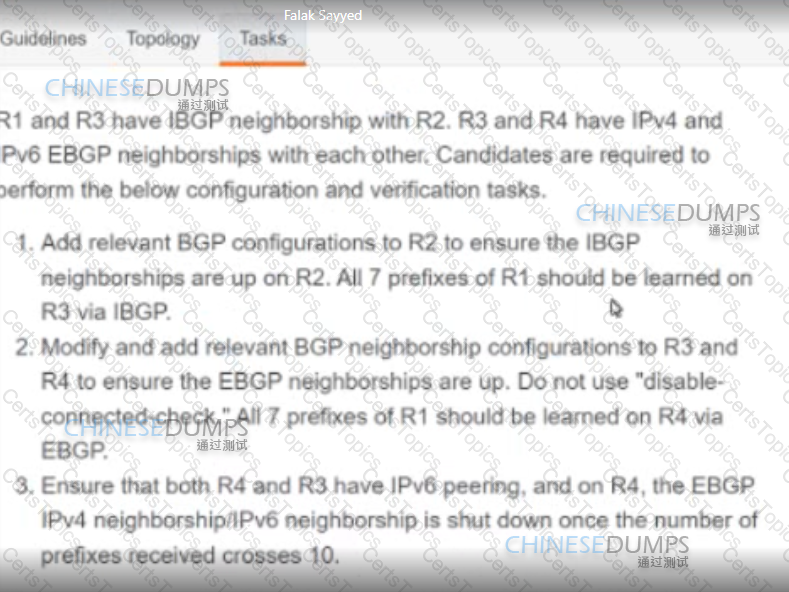
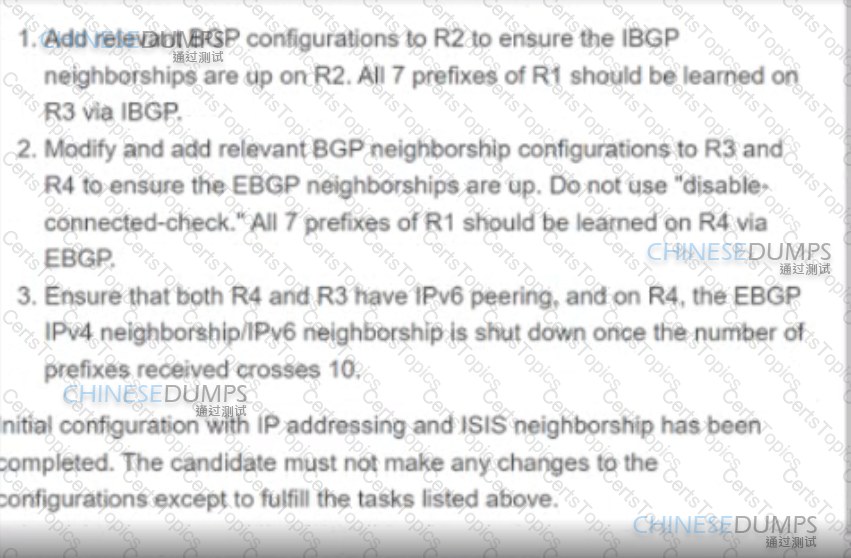
Drag and drop the LDP features from the left onto their usages on the right.

A network operator working for a telecommunication company with an employee Id: 4065 96080 it trying to implement BFD configuration on an existing network of Cisco devices Which task must the engineer perform to enable BFD on the interfaces?
A network engineer is configuring a newly installed PE router at the regional gateway location. The new PE router must use MPLS core routing protocols with the existing P router, and LDP sessions between the two routers must be protected to provide faster MPLS convergence. Which configuration must the engineer perform on the network so that LDP sessions are established?
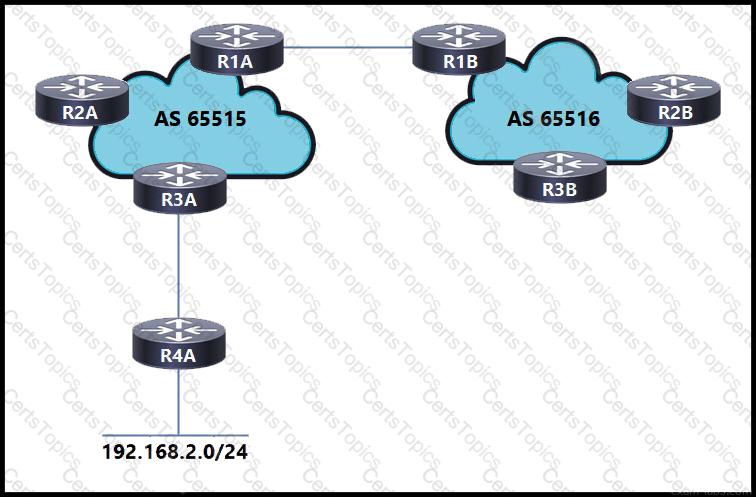
Refer to the exhibit. An engineer working for a private telecommunication company with an employee id: 3414:81:713 is implementing this network, in which:
Routers R1A and R1B are eBGP neighbors.
iBGP is configured within AS 65515 and AS 65516.
Network 192.168.2.0/24 is shared with AS 65516.
Router R3A has an iBGP relationship with router R2A only.
Router R2A has an iBGP relationship with routers R1A and R3A.
Which additional task must the engineer perform to complete the configuration?
An engineer must implement QoS to prioritize traffic that requires better service throughout the network. The engineer started by configuring a class map to identify the high-priority traffic. Which additional tasks must the engineer perform to implement the new QoS policy?
Guidelines -
This is a lab item in which tasks will be performed on virtual devices.
• Refer to the Tasks tab to view the tasks for this lab item.
• Refer to the Topology tab to access the device console(s) and perform the tasks.
• Console access is available for all required devices by clicking the device icon or using the tab(s) above the console window.
• All necessary preconfigurations have been applied.
• Do not change the enable password or hostname for any device.
• Save your configurations to NVRAM before moving to the next item.
• Click Next at the bottom of the screen to submit this lab and move to the next question.
• When Next is clicked, the lab closes and cannot be reopened.
Topology:
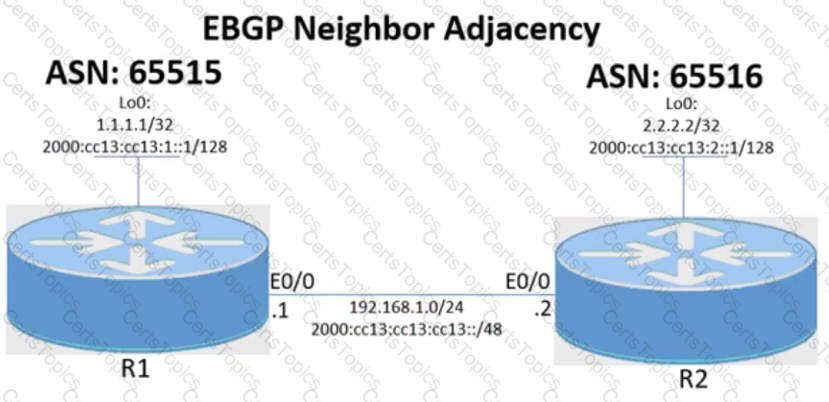
Tasks -
Configure the BGP routing protocol for R1 and R2 according to the topology to achieve these goals:
1. Configure EBGP neighbor adjacency for the IPv4 and IPv6 address family between R1 and R2 using Loopback0 IPv4 and IPv6 addresses. All BGP updates must come from the Loopback0 interface as the source. Do not use IGP routing protocols to complete this task.
2. Configure MD5 Authentication for the EBGP adjacency between R1 and R2. The password is clear text C1sc0!.
A network engineer is testing an automation platform that interacts with Cisco networking devices via NETCONF over SSH. In accordance with internal security requirements:
NETCONF sessions are permitted only from trusted sources in the 172.16.20.0/24 subnet.
CLI SSH access is permitted from any source.
Which configuration must the engineer apply on R1?
You are testing the capabilities of MPLS OAM ping.
Which statement is true?
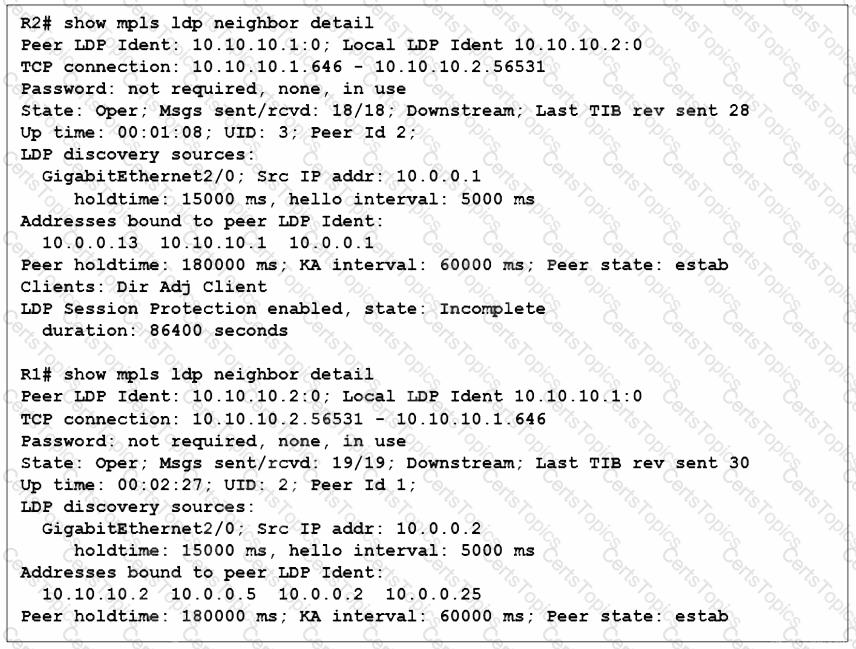
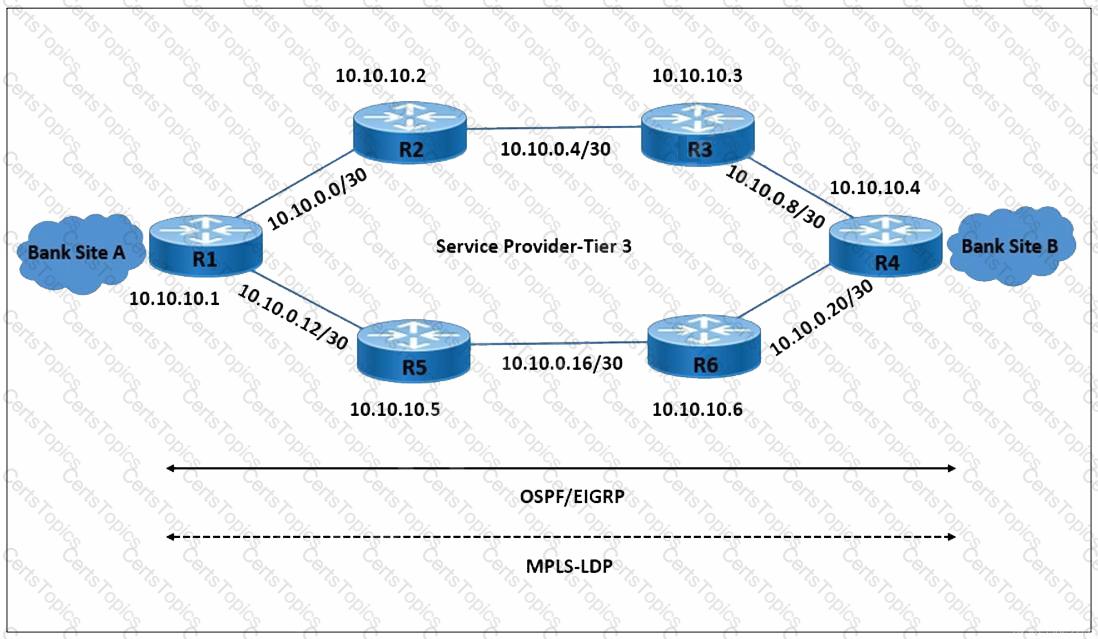
Refer to the exhibit. LDP peering between routers R1 and R2 is dropped when the link between R1 and R2 is taken offline. However, LDP peering between R2 and R3 stays up when the link between R2 and R3 is taken offline. Which action allows MPLS traffic forwarding to continue normally if the link between R1 and R2 goes down?
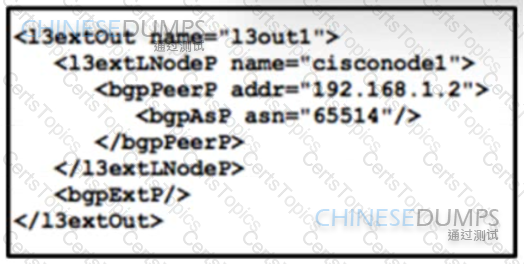
Refer to the exhibit. A global company plans to implement BGP at its newest location to provide connectivity to other offices. The global infrastructure of the company is a multivendor environment. An engineer must review the BGP core configurations at headquarters to determine if they can be repurposed at the new location. The engineer copied this JSON script for review. What is the effect of the script?
A network engineer is deploying VPLS configuration between multiple PE routers so that customer's remote offices have end-to-end LAN connectivity. Which additional configuration should the engineer perform on the PE routers to enable the virtual switch instance?
A)

B)
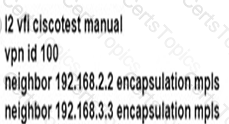
C)
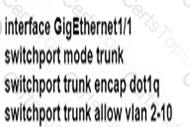
D)
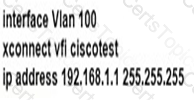
A network engineer must collect traffic statistics for an internal LAN toward the internet The sample must include the source and destination IP addresses, the destination ports, the total number of bytes from each flow using a 64-bit counter, and all transport flag information. Because of CPU limits, the flow collector processes samples that are a maximum of 20 seconds long. Which two configurations must the network engineer apply to the router? (Choose two.)
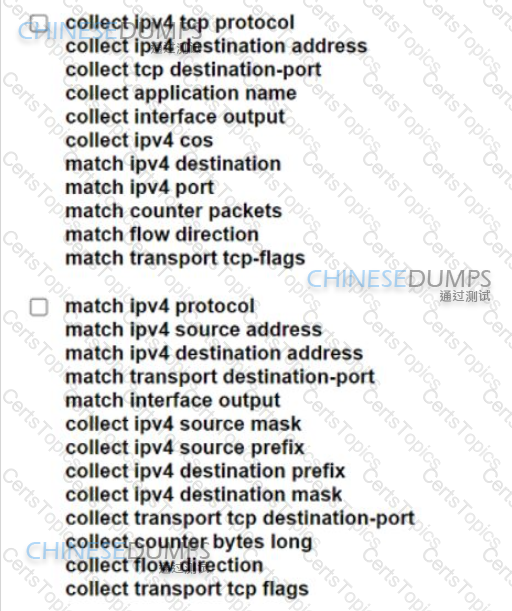
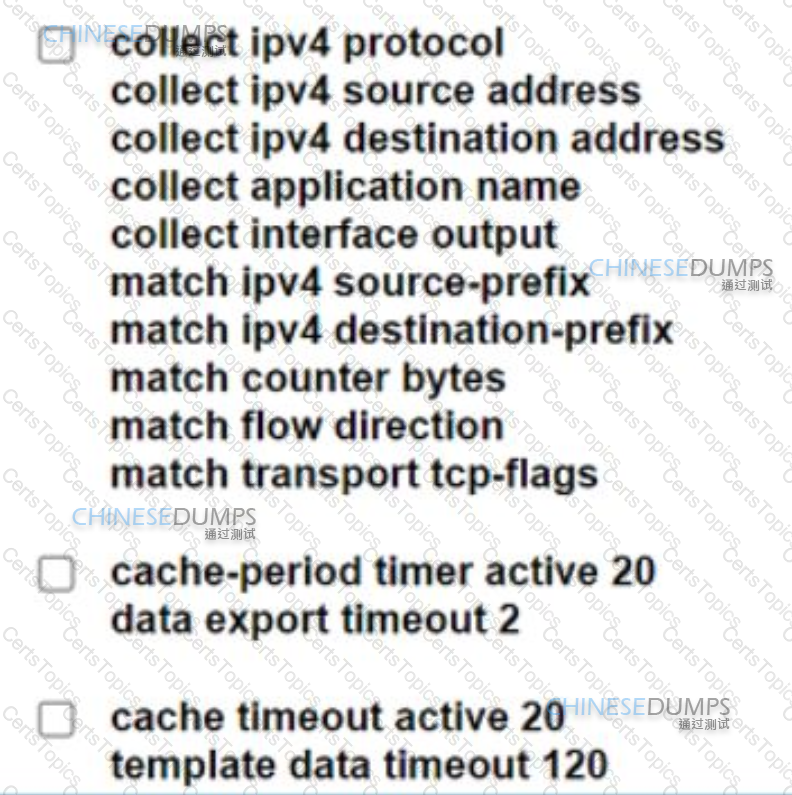
Refer to me exhibit.
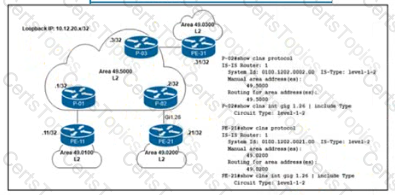
Refer to the exhibit. A network engineer notices PE-21 convergence degradation due to the growing LSDB size of Level 2 areas in the network. The engineer decides to migrate router PE-21 from an inter-area design to an intra-area implementation. Inter-area routing must be accomplished via an ATT-bit set by the Level 1/Level 2 router. Which configuration must the engineer implement on PE-21 to complete the migration?
Refer to the exhibit.
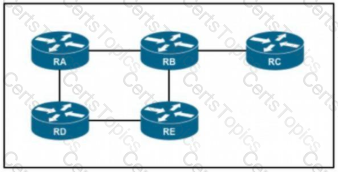
If RC is a stub router, which entry must be injected so that it will send traffic outside the OSPF domain?
Which technology enables the addition of new wavelengths in a fiber-optic network?
Refer to the exhibit.
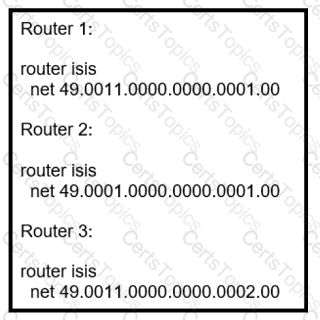
Router 4 is added to the network and must be in the same area as router 1. Which NET should the engineer assign?
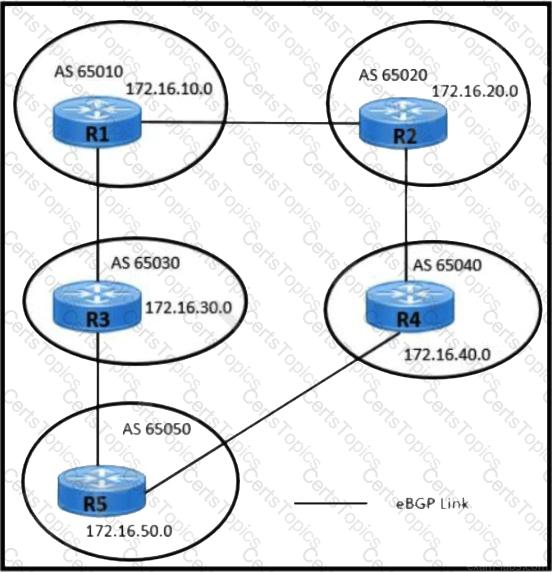
Refer to the exhibit. Users in AS 65010 are connected with the application server in AS 65050 with these requirements:
AS 65010 users are experiencing latency and congestion to connect with application server 172.16.50.10.
AS 65030 must be restricted to become Transient Autonomous System for traffic flow.
Links connected to AS 65020 and AS 65040 are underutilized and must be used efficiently for traffic.
Which two configurations must be implemented to meet these requirements? (Choose two.)
Refer to the exhibit.
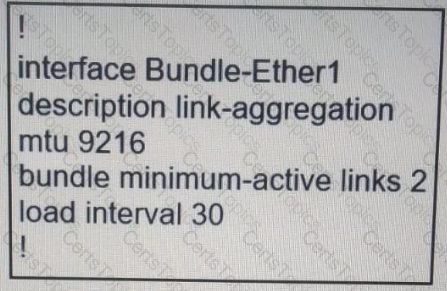
Which the link aggregation configuration router is running on Cisco IOS XR software, which LACP interface configuration is needed to add the interface to the bundle?
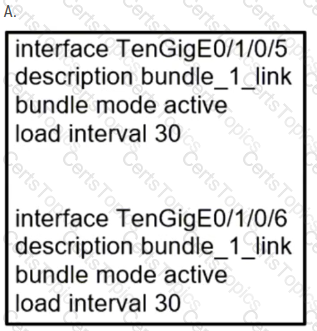
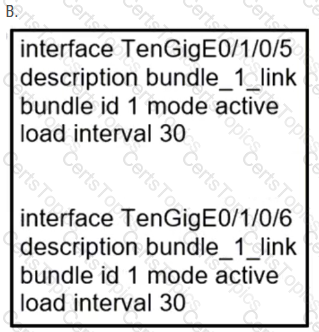
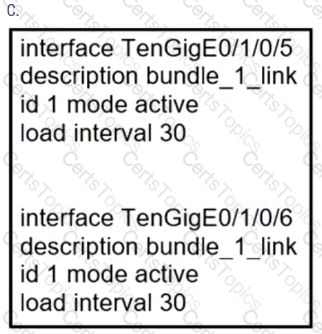
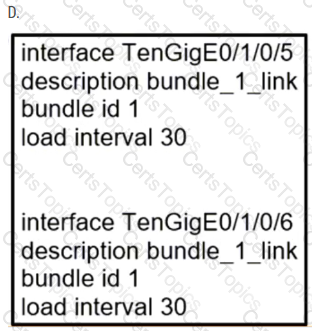
How can shared services in an MPLS Layer 3 VPN provide Internet access to the customers of a central service provider?
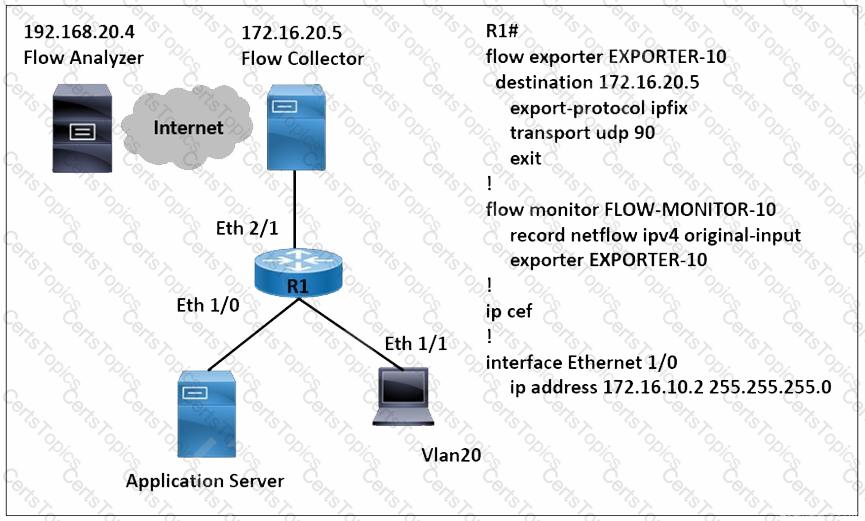
Refer to the exhibit. A network engineer wants to monitor traffic from the application server and send the output to the external monitoring device at 172.16.20.5. Application server traffic should pass through the R1 Eth2/1 interface for further analysis after it is monitored. Which configuration must be applied on the R1 router?
A network engineer is deploying VRF on ASBR router R1. The interface must have connectivity over an MPLS VPN inter-AS Option AB network. Which configuration must the engineer apply on the router to accomplish this task?
A)

B)

C)

D)

Refer to the exhibit. An organization s network recently experienced several significant outages due to device failures. The network administrator just moved the network devices to a new central data center, and packets are switched using labels. The administrator Is now implementing NSF on the network to reduce potential risk factors in the event of another outage. Which task must the administrator perform on each router as part of the process?

Refer to the exhibit.

A network engineer is implementing OSPF multiarea. Which command on interface GO/1 resolves adjacency issues in the new area?
After implement MPLS protocol for multiple VRFs on a single Cisco device, the engineer notices all VRFs on the router still do to not LDP session protection feature enabled. Which configuration must the engineer apply to enable the LDP session protection feature FOR LDP neighbors within each VRF?
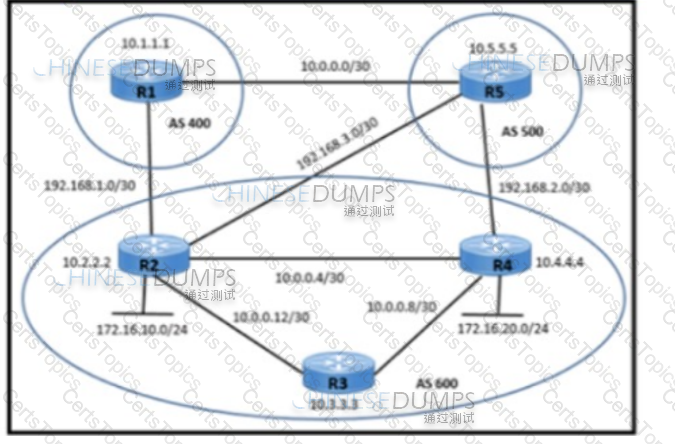
Refer to the exhibit. A network engineer is implementing iBGP and eBGP between AS 600 and AS 500 with these requirements:
Which action must be taken on R2 to meet the requirements?
What is a primary benefit of IPoATM or MPLS over ATM backbone service provider networks?

Guidelines
-
This is a lab item in which tasks will be performed on virtual devices.
• Refer to the Tasks tab to view the tasks for this lab item.
• Refer to the Topology tab to access the device console(s) and perform the tasks.
• Console access is available for all required devices by clicking the device icon or using the tab(s) above the console window.
• All necessary preconfigurations have been applied.
• Do not change the enable password or hostname for any device.
• Save your configurations to NVRAM before moving to the next item.
• Click Next at the bottom of the screen to submit this lab and move to the next question.
• When Next is clicked, the lab closes and cannot be reopened.
Topology
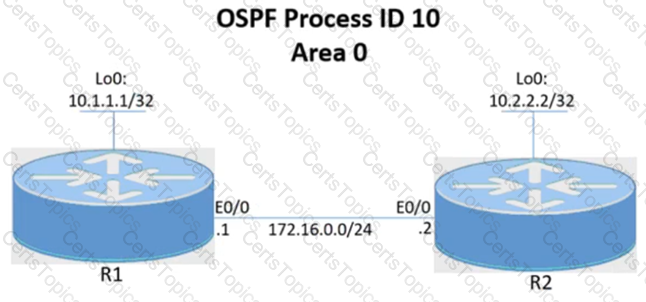
Tasks
-
Configure and verify the OSPF neighbor adjacency between R1 and R2 in OSPF area 0 according to the topology to achieve these goals:
1. Establish R1 and R2 OSPF adjacency. All interfaces must be advertised in OSPF by using the OSPF interface command method. Use Loopback0 as the OSPF ID.
2. There must be no DR/BDR elections in OSPF Area 0 when establishing the neighbor relationship between R1 and R2. OSPF must not generate the host entries /32 for the adjacent interfaces.
3. Enable OSPF MD5 Authentication between both routers at the interface level with password C1sc0!.
Drag and drop the OSPF area types from the left onto the correct statements on the right

An engineer must extend Layer 2 Between two campus sites connected through an MPLS backbone that encapsulates Layer 2 and Layer 3 data Which action must the engineer perform on the routers to accomplish this task?
Which two PHY modes are available to implement an IOS XR Gigabit Ethernet interface interface? (Choose two.)
An engineer working for telecommunication company with an employee id: 3715 15 021 needs to secure the LAN network using a prefix list Which best practice should the engineer follow when he implements a prefix list?
What is the difference between SNMP and model-driven telemetry?
How can a network administrator secure rest APIs?
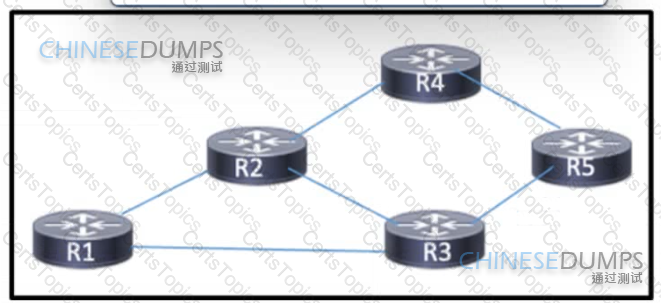
Refer to the exhibit. Routers R1 through R5 are being deployed within the core of a service provider running BGP The core supports distribution of VPNv4 routes using MPLS. R3 currently has multiple paths to reach R4. A network engineer must implement BGP attributes so that R3 can reach R4 via R1. Which action must the engineer take to meet the requirement?
Which task must be performed first to Implement BFD in an IS-IS environment?
An engineer Is implementing NSR with OSPF on a large campus that requires high availability. Which task must an engineer perform to complete the process with minimal disruption to traffic?
FRR is configured on a network. What occurs when the headend router on the path is alerted to a link failure over IGP?
Refer to the exhibit.
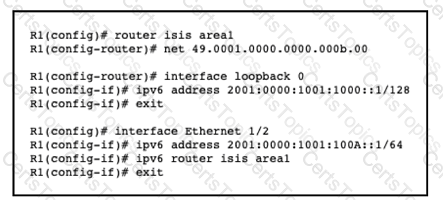
A network engineer with an employee id: 3812:12:993 has started to configure router R1 for IS-IS as shown. Which additional configuration must be applied to configure the IS-IS instance to advertise only network prefixes associated to passive interfaces?
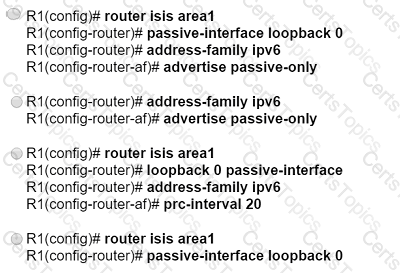
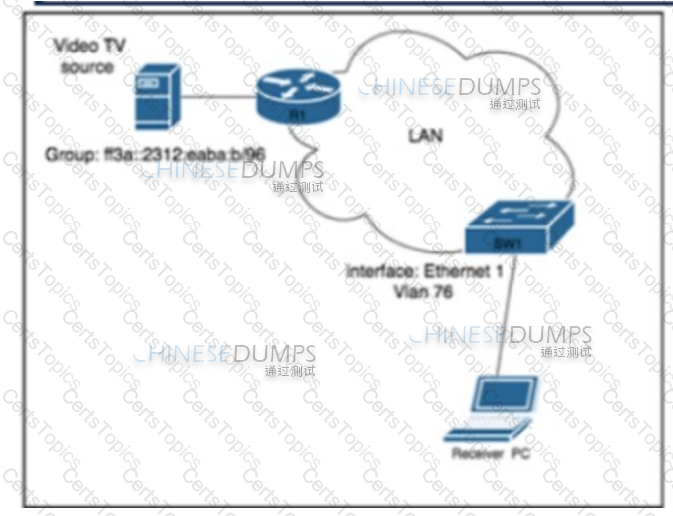 l
l
Refer to the exhibit. A network engineer working for a telecommunication company with an employee ID: 4602:62:646 is configuring security controls for the IPv6 multicast group, which is used for video TV. The solution from the engineer should reduce network usage and minimize the leave latency for the user that is connected to VLAN 76. Which two configurations meet this goal? (Choose two.)
A)

B)

C)

D)

E)

Refer to the exhibit:

Which statement describes the effect of this configuration?
Refer to the exhibit:

Which statement describes this configuration?
Refer to the exhibit:
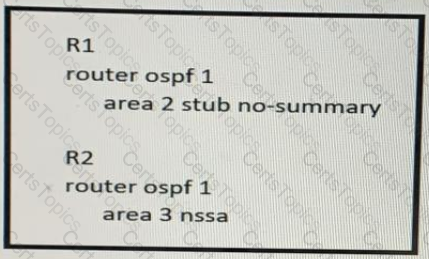
In which way does router R1 operate differently than router R2?
A router is advertising multiple networks to its BGP neighbor in AS 5200 with peer IP address 1.1.1.1. Which configuration must be applied so that the router permits updates only for networks with a prefix mask length less than or equal to 21?
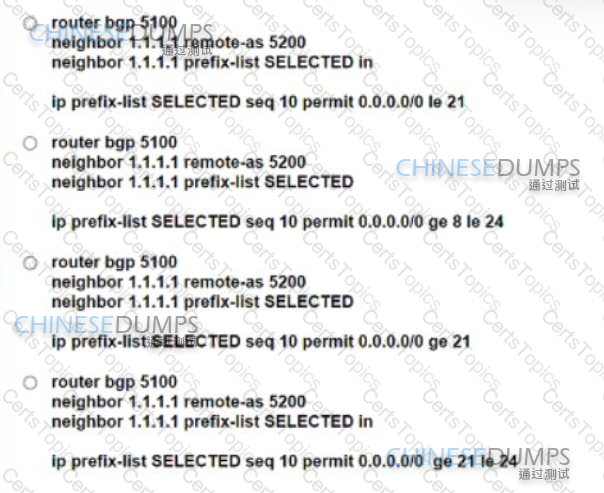
Why do packet loops occur during the configuration of BlDlR-PIM?
Refer to the exhibit.
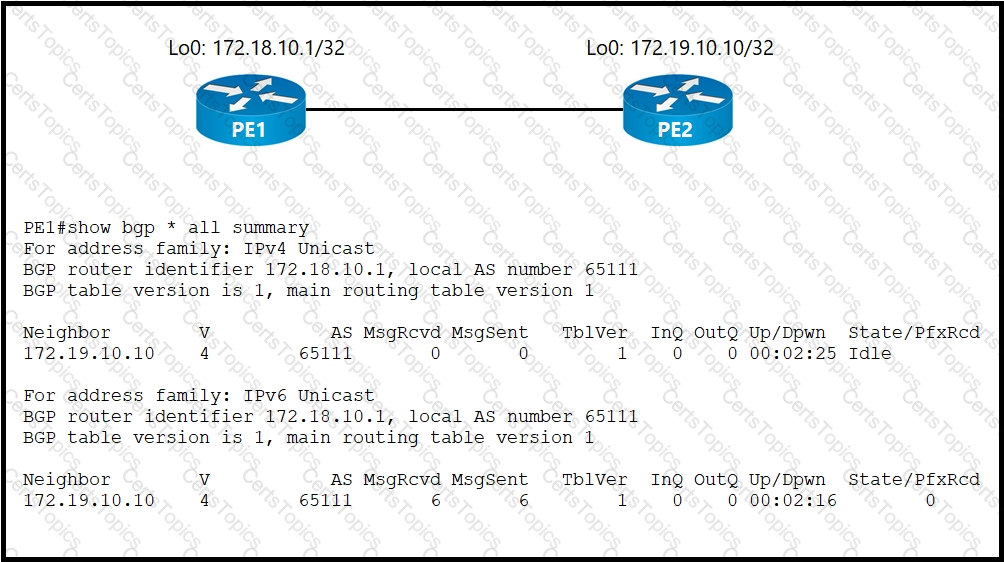
An administrator working for large ISP must connect its two POP sites to provide internet connectivity to its customers. Which configuration must the administrator perform to establish an iBGP session between routers PE1 on POP site 1 and PE2 on POP site 2?
Which protocol is used for communication between the PCE and PCC?
Refer to the exhibit:
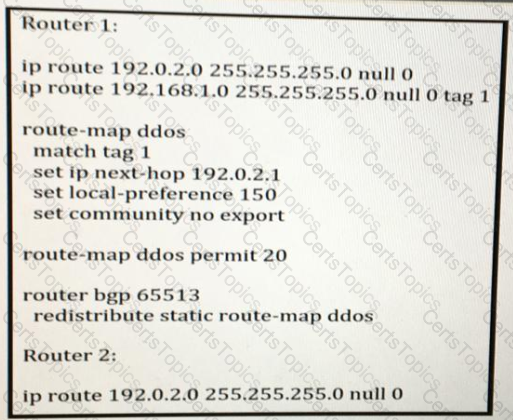
An engineer is preparing to implement data plane security configuration.
Which statement about this configuration is true?
Refer to the exhibit.
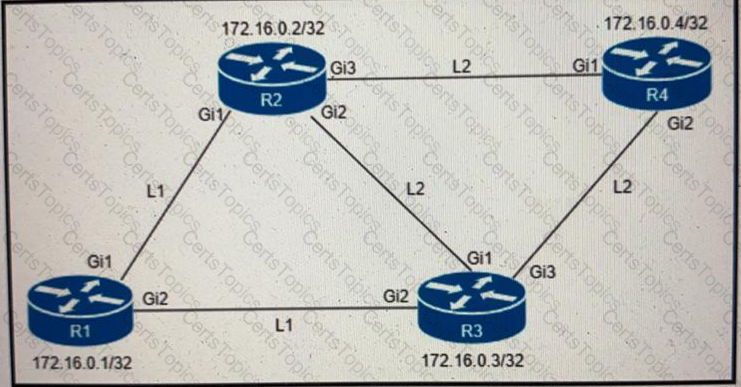
An engineer must configure router R2 as the new P router in the network. Which configuration must be applied to R2 to enable LDP-IGP Sync on its L2 IS-IS adjacencies?
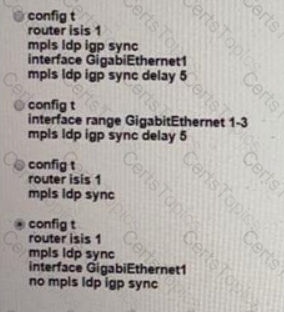
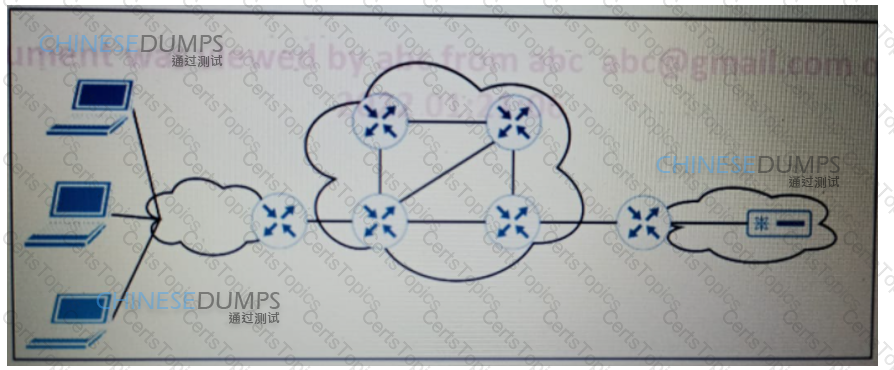
Refer to the exhibit. ISP A provides VPLS services and DDoS protection to Company XYZ to connect their branches across the North America and Europe regions. The uplink from the data center to the ISP is Mbps. The company XYZ security team asked the ISP to redirect ICMP requests which are currently going to the web server to a new local security appliance which configuration must an ISPP engineer apply to router R2 to redirect the ICMP traffic?
A)

B)

C)

D)

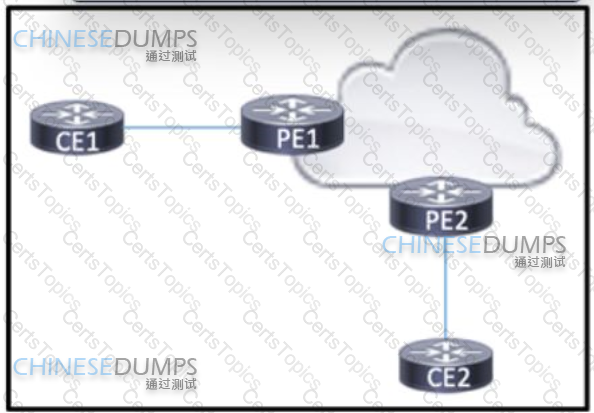
Refer to the exhibit BGP is running in the core of the service provider to exchange routes for its customers, and OSPF serves as the PE-CE routing protocol. The service provider s existing customer at CE1 is opening a new office in a different geographical location connected via CE2. A network engineer must update the BGP implementation so that PE1 and PE2 will share routes and provide communication between CE1 and CE2 Which action must the engineer take?
Refer to the exhibit:

Which statement about the neighbor statements for 192.168.1.1 is true?
What is a characteristics of the Pipe model for MPLS QoS?
How does model-driven telemetry use YANG?
Drag and drop the functions from the left onto the correct Path Computation Element Protocol roles on the right

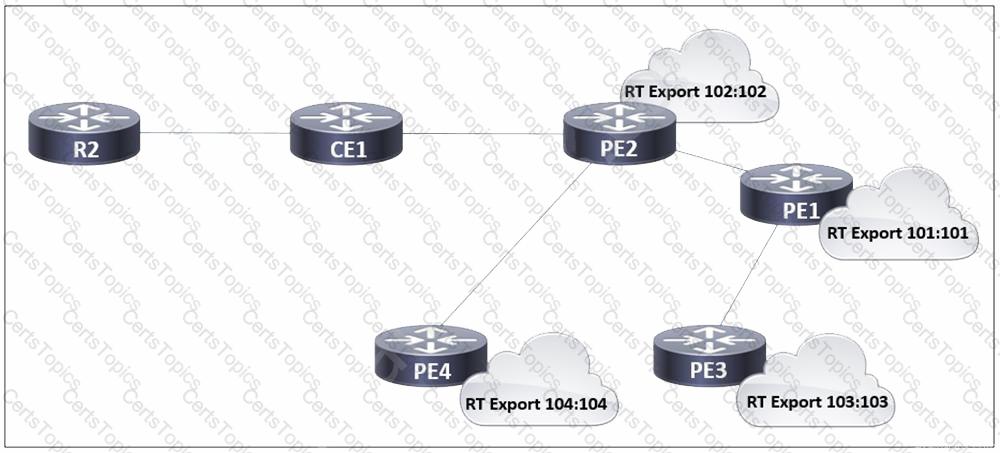
Refer to the exhibit. In the service provider network, routers PE1, PE2, and PE4 have access to the internet and provide access to customer networks. Router PE3 is used for access to other customer systems. In accordance with a new SLA, an engineer is updating settings on this network so that router CE1 accesses the internet via PE1 instead of PE2. Which two tasks must the engineer perform to complete the process? (Choose two.)
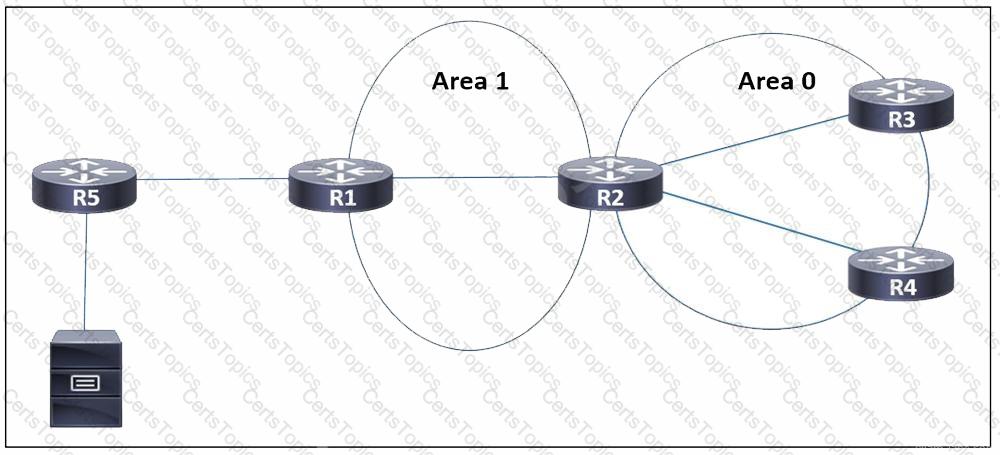
Refer to the exhibit. EIGRP is running between routers R5 and R1, and OSPF is used in the rest of the network. Users in a network attached to router R3 need to access a server connected to R5. Which task must the engineer perform so that only the users attached to R3 are able to access the server, but no other network is shared to OSPF?
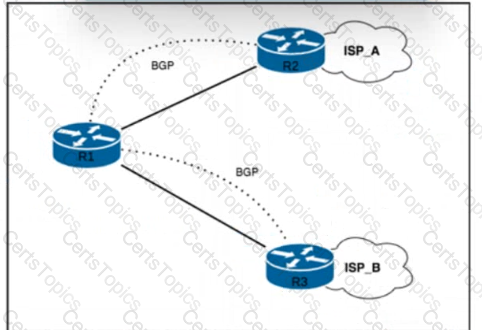
Refer to the exhibit. R1 has two upstream Tier 1 service providers. BGP is in use as the exterior routing protocol, and ISP_A and ISP_B are sending the full BGP table. A network engineer must assign local-preference 70 to all routes with multiple exit discriminator 30. Which configuration must the network engineer apply?
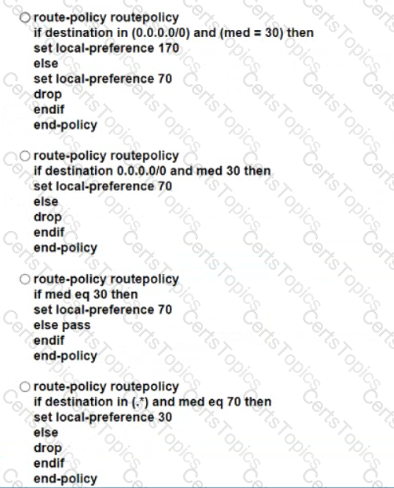
Drag and drop the characteristics from the left onto the automation tool on the right.
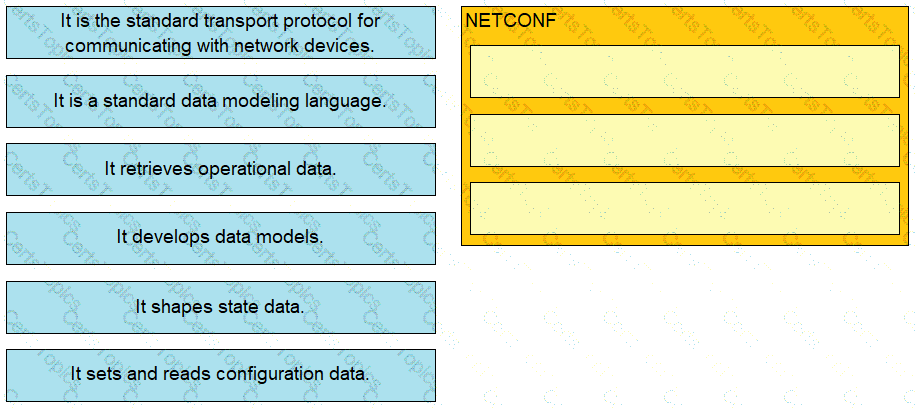
Refer to the exhibit.
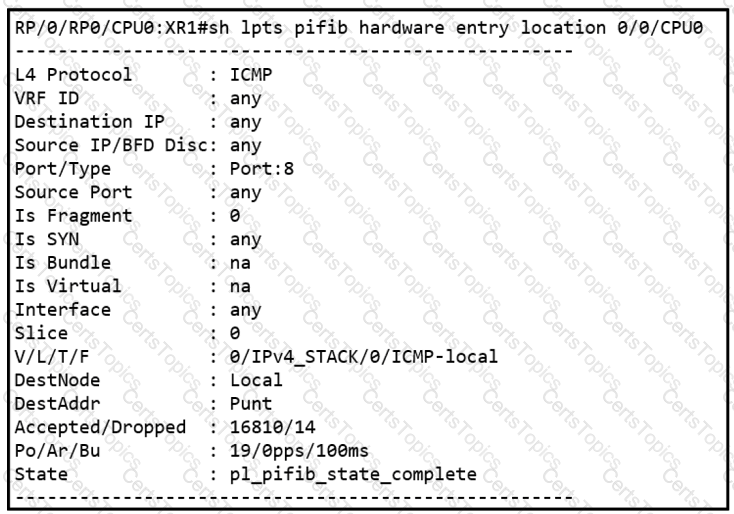
While troubleshooting the network, a network operator with an employee id: 3812:12:993 is trying to ping XR1. Which result should the operator expect when trying to ping to an XR1 local address?
Which component is similar to an EVPN instance?
After you analyze your network environment, you decide to implement a full separation model for Internet access and MPLS L3VPN services For which reason do you make this decision?
A regional MPLS VPN provider operates m two regions and wants to provide MPLS L 3VPN service for a customer with two sites in these separate locations. The VPN provider approaches another organization to provide backbone carrier services so that the provider can connect to these two locations.
Which statement about this scenario is true?
Which OoS model allows hosts to report their QoS needs to the network?
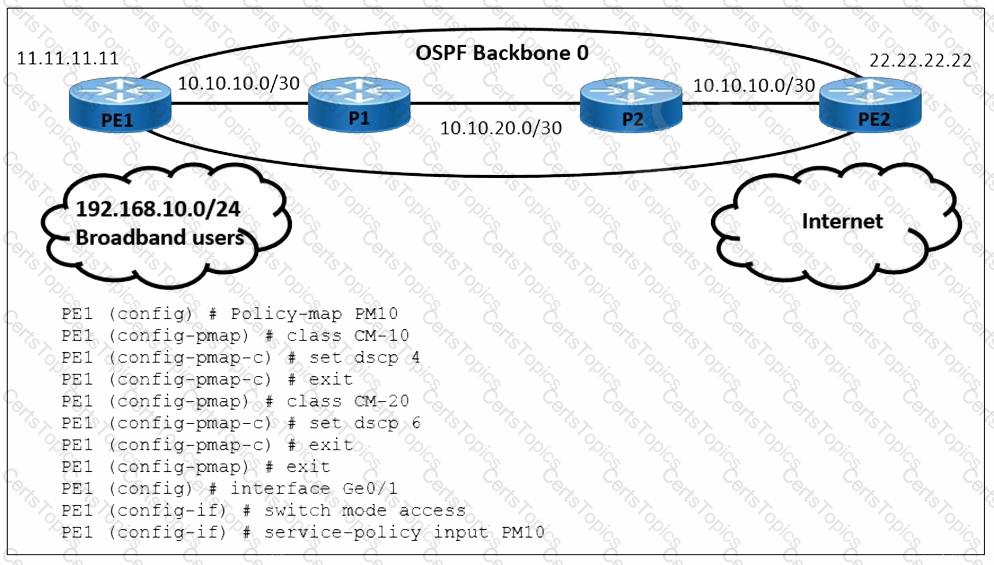
Refer to the exhibit A user is performing QoS marking on internet traffic and sending it with IPv4 and IPv6 headers on the provider edge device PE1. IPv4 traffic is classified with DSCP 4 and IPv6 traffic is classified with DSCP 6. Which action must the engineer take to begin implementing a QoS configuration on PE1 for the IPv6 traffic?
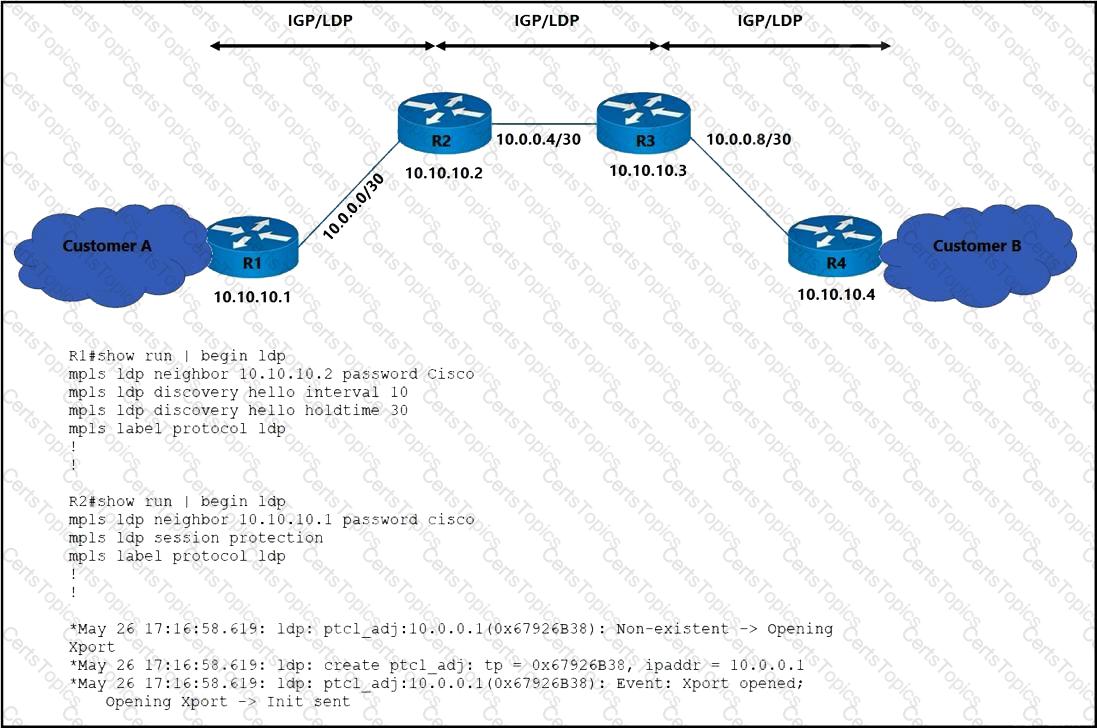
Refer to the exhibit. The operations team is implementing an LDP-based configuration in the service provider core network with these requirements:
R1 must establish LDP peering with the loopback IP address as its Router-ID.
Session protection must be enabled on R2.
How must the team update the network configuration to successfully enable LDP peering between R1 and R2?
A network architect must implement CSC VPN services for a new backbone carrier. Which two benefits does the architecture provide? (Choose two.)
An engineer is moving all of an organization’s Cisco IOS XE BGP routers to the address-family identifier format. Which command should be used to perform this upgrade quickly with the minimum service disruption?
What are two factors to consider when implementing NSR High Availability on an MPLS PE router? (Choose two.)
Refer to the exhibit.
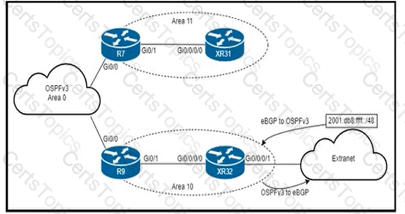
An engineer is updating this network to meet these conditions:
• Area 10 will receive inter-area routes and support mutual redistribution of external routes with the extranet.
• The ::/0 route is prohibited in Area 10.
• Area 11 will receive only the ::/0 route from the ABR.
• External route redistribution is not supported in Area 11.
• The ABR in Area 11 will advertise no interarea routes.
Which two configurations must be performed to meet the requirements? (Choose two.)
Refer to the exhibit:

Which configuration prevents the OSPF neighbor from establishing?
What is the primary role of a BR router in a 6rd environment?
Which characteristic describes prefix segment identifier?
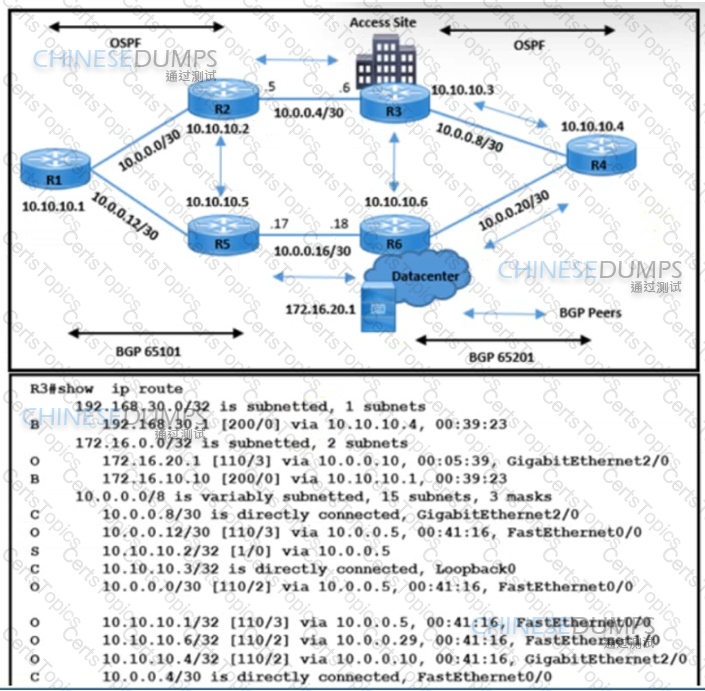
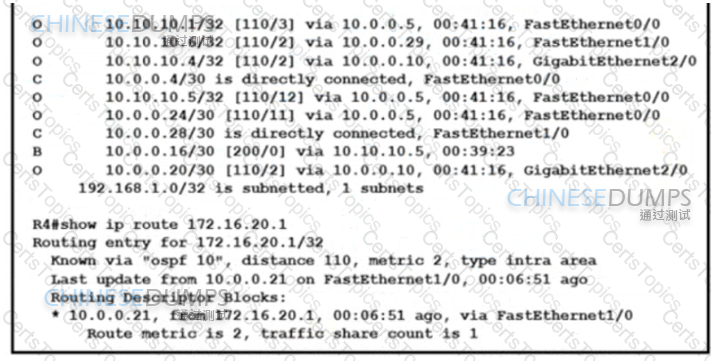
Refer to the exhibit. The network operations team reported that the access site that is connected to R3 is not connecting to the application server in the data center and that all packets that are sent from the application server to the access site are dropped. The team verified that OSPF and BGP peerings are up in BGP AS 65101 and BGP AS 65201. R4 is expected to receive traffic from the application server route via OSPF. Which action resolves this issue?
Refer to the exhibit.

An engineer is implementing BGP selective prefix suppression. The router must advertise only 10.16.4.0/24,10.16.5.0/24. and summarized route 10.16.0.0/21. and suppress 10.16.6.0/24. Which configuration must the engineer apply to the router?
A)

B)

C)

D)

Drag and drop the BGP Best Path Algorithm rules from the left into the corresponding order of importance on the right.
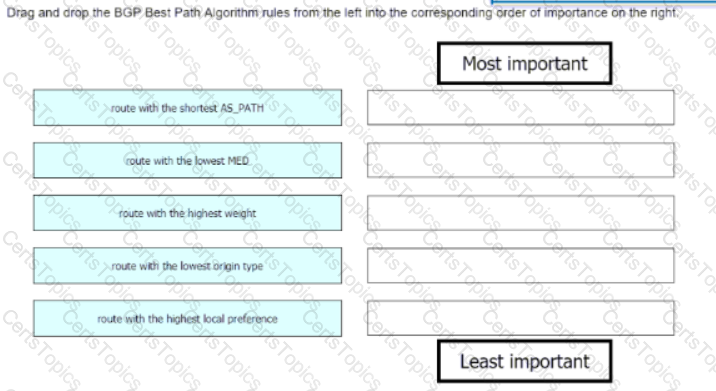
Refer to the exhibit.
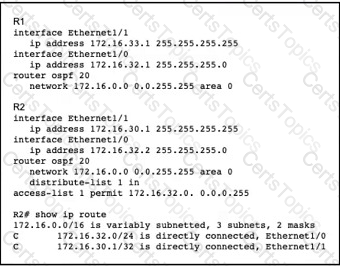
A network engineer notices that router R2 is failing to install network 172.16.33.1/32 in the routing table. Which configuration must the engineer apply to R2 to fix the problem?
Which additional feature does MPLS DiffServ tunneling support?
Refer to the exhibit:
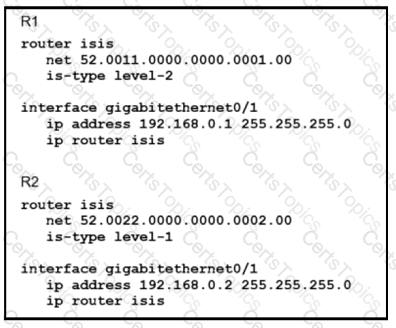
Which statement about the status of the neighbor relationship between R1 and R2 is true?
What is a constraint of Cisco MPLS TE tunnel configurations?
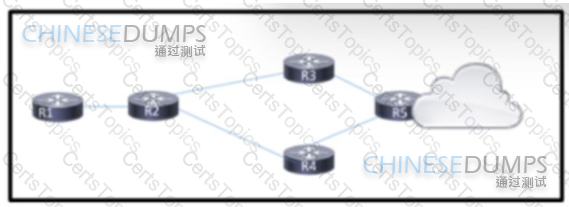
Refer to the exhibit. An engineer is scripting ACLs to handle traffic on the given network. The engineer must block users on the network between R1 and R2 from leaving the network through R5. but these users must still be able to access all resources within the administrative domain. How must the engineer implement the ACL configuration?
What are the two uses of the YANG data modeling language? (Choose two.)
Which condition must be met for TI-LFA to protect LDP traffic?
Refer to the exhibit.
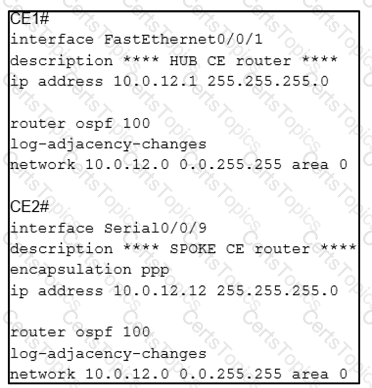
A network engineer is configuring customer edge routers to finalize a L2VPN over MPLS deployment Assume that the AToM L2VPN service that connects the two CEs is configured correctly on the service provider network Which action causes the solution to fail?
Which feature describes the adjacency SID?
How is RSVP used with MPLS traffic engineering tunnels?
An engineer needs to implement QOS mechanism on customer's network as some applications going over the internet are slower than others are. Which two actions must the engineer perform when implementing traffic shaping on the network in order to accomplish this task? (Choose two)
How does an untrusted interface at the boundary of an administrative domain handle incoming packets?
Refer to the exhibit. After a networking team configured this MPLS topology, the supervisor wants to view MPLS labels to verify the path that packets take from router R1 to router R7 The team already Issued an ICMP ping to verify connectivity between the devices. Which task must the team perform to allow the supervisor to view the label switch path?

Refer to the exhibit:

What does this value mean when it is received in XML?
Refer to the exhibit.
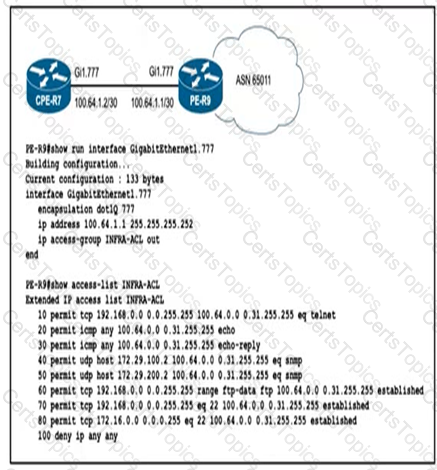
To protect in-band management access to CPE-R7, an engineer wants to allow only SSH management and provisioning traffic from management network 192.168.0.0/16. Which infrastructure ACL change must be applied to router PE-R9 to complete this task?
A)

B)

C)

D)

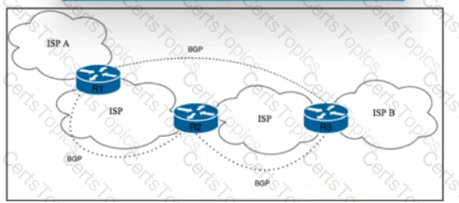
Refer to the exhibit. Tier 1 ISP A is connected to small Tier 3 ISP B. The EBGP routing protocol is used for route exchange. The networking team at ISP A noticed the flapping of BGP sessions with ISP B. The team decides to Improve stability on the network by suppressing the subnet for 30 minutes when a session begins to flap. Which action must the team perform to meet this goal?
Which feature describes the weight parameter for BGP path selection?

Refer to the exhibit. A network operator is attempting to configure an IS-IS adjacency between two routers, but the adjacency cannot be established. To troubleshoot the problem, the operator collects this debugging output. Which interface are misconfigured on these routers?

Refer to the exhibit.
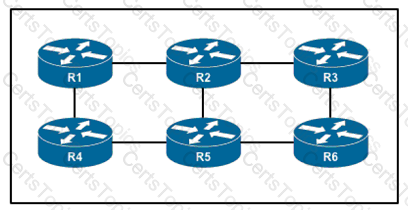
An engineer is configuring an administrative domain in the given multi-vendor environment with PIM-SM. Which feature must the engineer implement so that devices will dynamically learn the RP?
Refer to the exhibit.
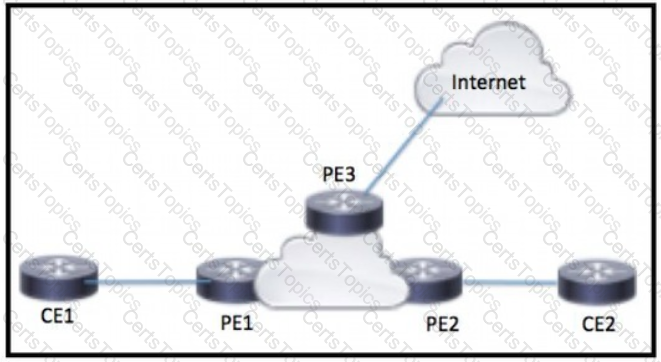
CE1 and CE2 require connectivity to the internet through the ISP connected to PE3 What should an engineer configure to complete this task?
What is the role of NSO?
Refer to the exhibit.
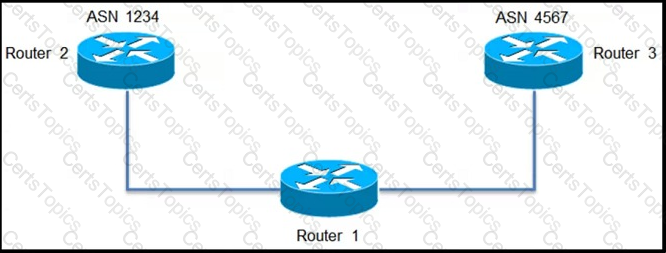
An engineer is configuring path selection on router R1 for two ASNs as shown. Which additional task must the engineer perform on Router 1 so that all outbound traffic utilizes the link between R1 and R3 to reach ASN 4567?
How does Cisco MPLS TE use OSPF extensions to allow for optimized transit between a headend router and a destination router?
What are two features of stateful NAT64?
A network operator needs to implement PIM-SSM multicast configuration on customer's network so that users in different domains are able to access and stream live traffic. Which two actions must the engineer perform on the network
to make the streaming work? (Choose two.)
Refer to the exhibit.

An engineer implemented OSPF neighbor relationship on an IOS device. Which configuration must be applied to get the OR/BOR election removed from interfaces running OSPF?
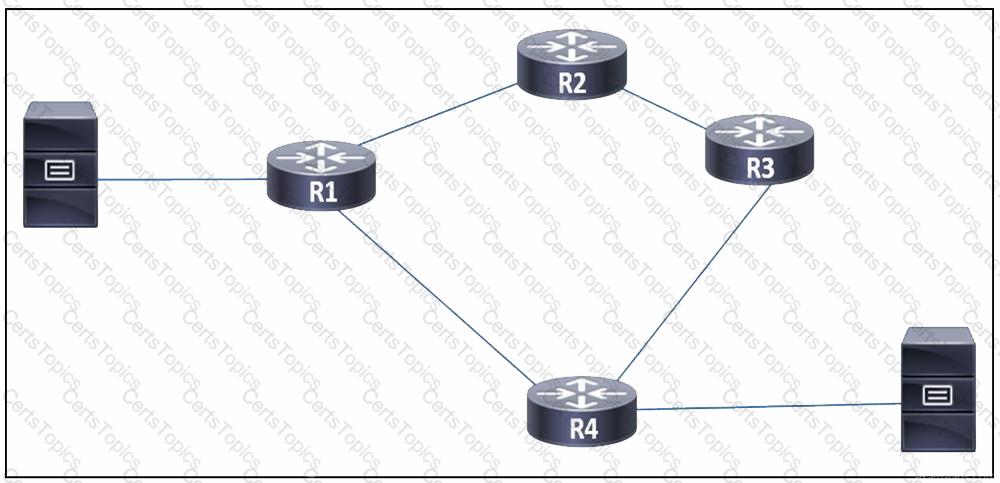
Refer to the exhibit. A network engineer observed congestion between routers R1 and R4, which are connected on a point-to-point link. Two servers that reside on networks on R1 and R4 generate heavy traffic between them with most traffic going from R4 to R1. To improve overall performance, the engineer wants to drop inbound packets that exceed a configured threshold, without disrupting traffic that passes from R4 to R3. Which action must the engineer take to resolve the issue?
Refer to the exhibit.
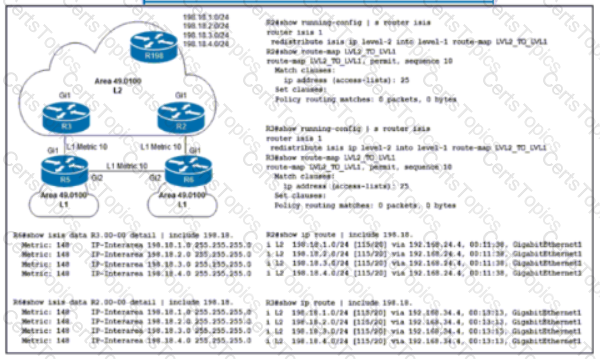
Routers R2 and R3 are Level 1/Level 2 IS-IS routers that redistribute 198 18.x.x/24 prefixes to routers R5 and R6 In the Level 1 area R2 Is to be the preferred router for all redistributed prefixes in the Level 1 area. Which configuration sets this preference?
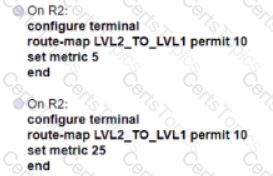
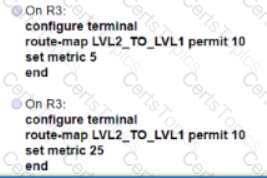
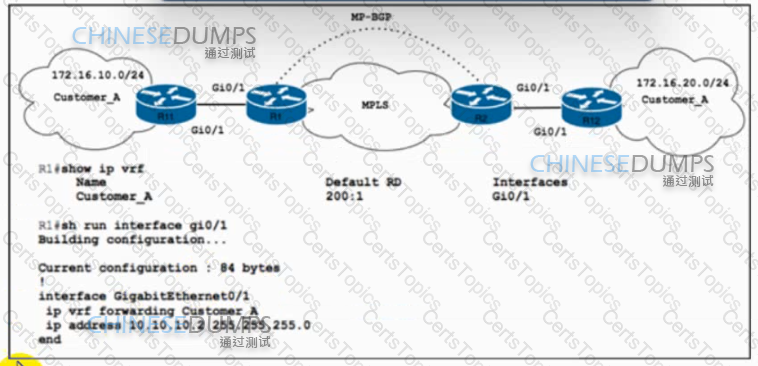
Refer to the exhibit. Customer_A asked ISP_A to connect two offices via an MPLS L3 VPN. Customer_A is currently using only the default route toward ISP_A. The engineer at ISP_A already configured the ip route vrf Customer_A 172.16.10.0 255.255.255.0 10.10.10.1 command on R1. Which action completes the configuration?
Refer to the exhibit.
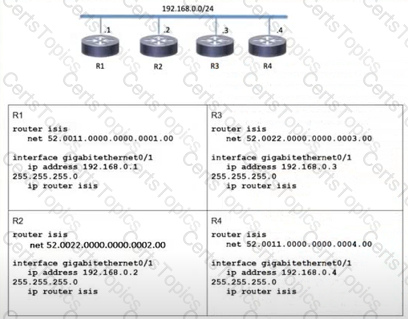
Which two topology changes happen to the IS-IS routers? (Choose two.)
Refer the exhibit.

Users on a network connected to router R3 report slow speeds when they connect to the server connected to R2. After analyzing traffic on the network, a network engineer identified congestion on the link between R2 and R3 as the cause. Which QoS service must the engineer implement to drop traffic on the link when it exceeds a configured threshold?
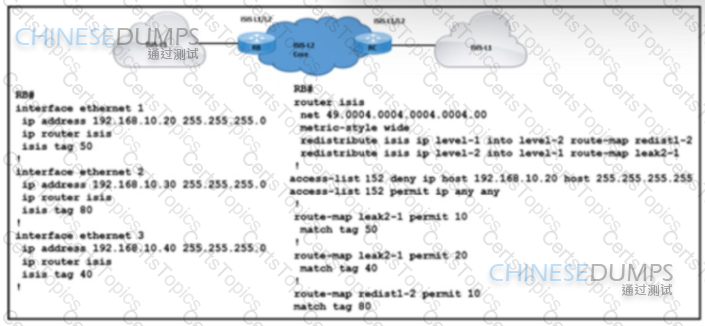
Refer to the exhibit. A network engineer with an employee ID 4379:43:595 is setting up an IS-IS network with these requirements:
Which configuration must be implemented on RB to meet the requirements?
Drag and drop the NAT64 descriptions from the left onto the correct NAT64 types on the right.

An engineer is trying to implement BGP in a multihomed architecture. What must the engineer configure to influence inbound path selection?
What is a feature of mVPN?
Refer to the exhibit:

Which effect of this configuration is true?
What must a network engineer consider when designing a Cisco MPLS TE solution with OSPF?
A company is expanding its existing office space to a new floor of the building, and the networking team is installing a new set of switches. The new switches are running IGMPv2, and the engineers configured them for VLAN10 only. The rest of the existing network includes numerous Layer 2 switches in multiple other VLANs, all running IGMPv3. Which additional task must the team perform when deploying the new switches so that traffic is switched correctly through the entire network?
Refer to the exhibit:
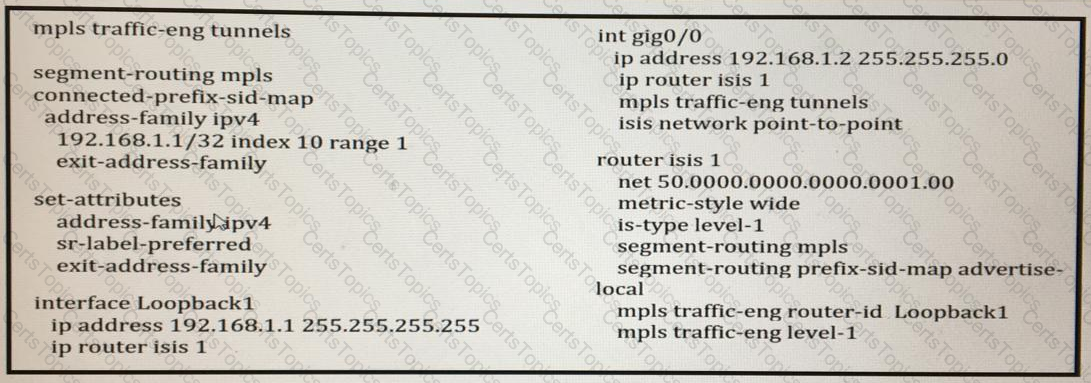
Which statement about this configuration is true"?
Refer to the exhibit.
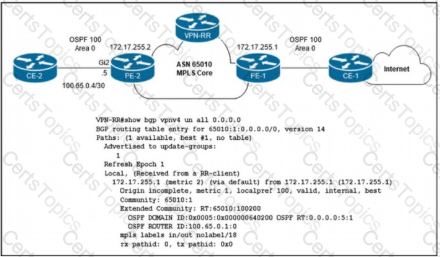
The network engineer who manages ASN 65010 is provisioning a customer VRF named CUSTOMER-ABC on PE-2. The PE-CE routing protocol is OSPF Internet reachability is available via the OSPF 0 0 0.0/0 route advertised by CE-1 to PE-1 In the customer VRF Which configuration must the network engineer Implement on PE-2 so that CE-2 has connectivity to the Internet?
A)
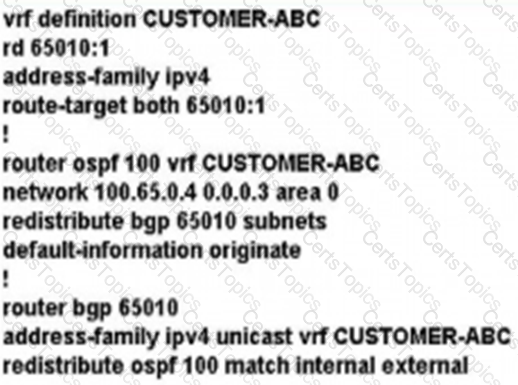
B)
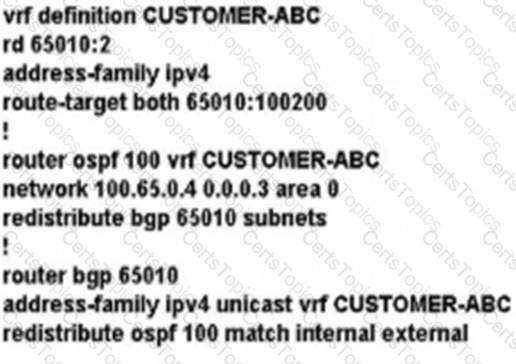
C)
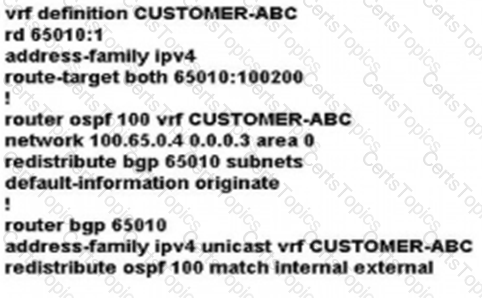
D)
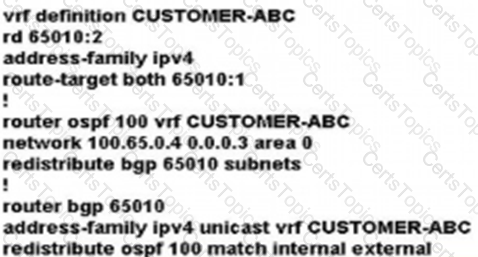

Refer to the exhibit. An engineer started to configure a router for OSPF. Which configuration must the engineer perform on the router without changing any interface configuration so that the router establishes an OSPF neighbor relationship with its peer?